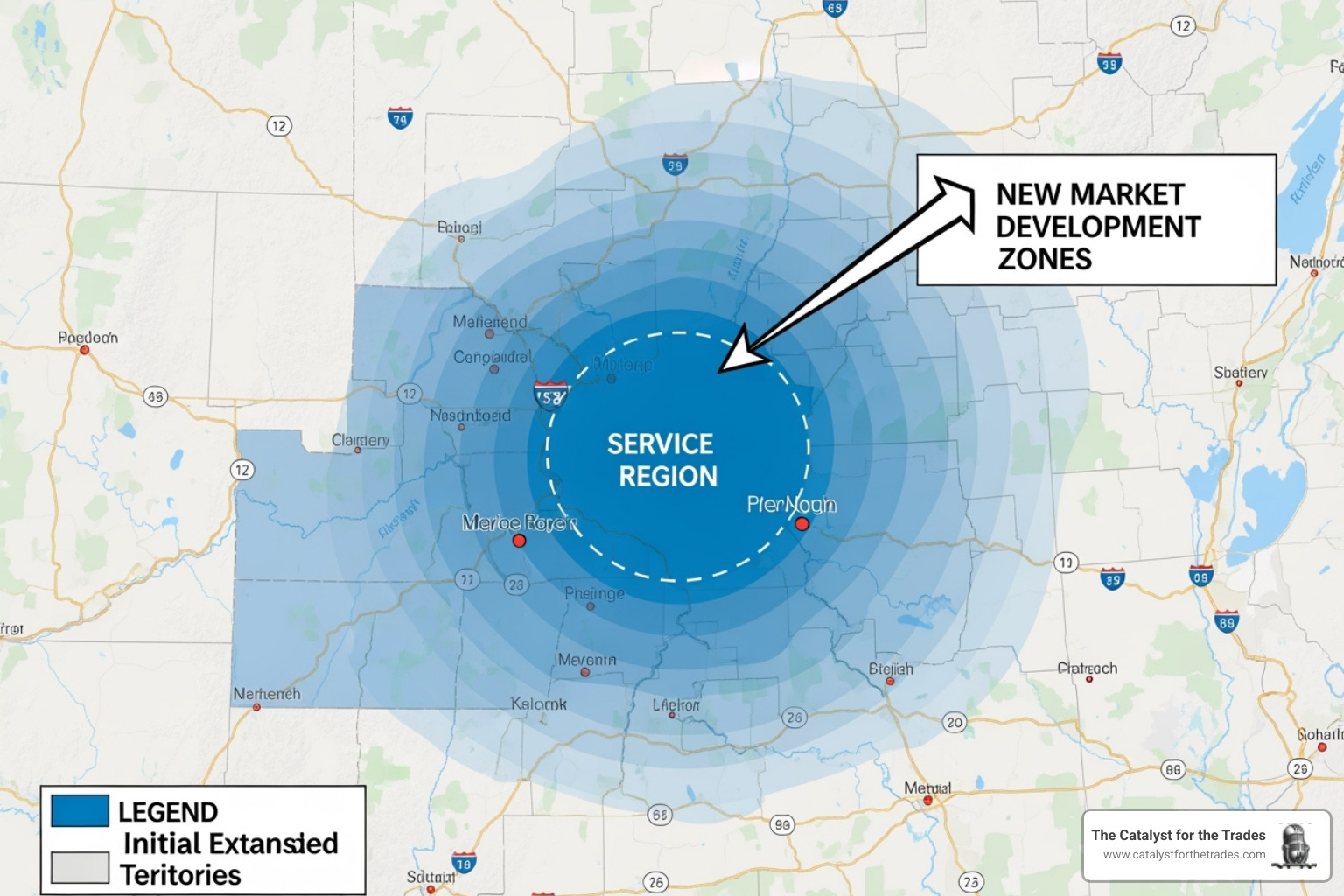Develop a winning technology strategy to future-proof your business. Align tech with goals, implement effectively, and leverage AI for growth.

The Growth Game: Six Strategies That Drive Performance
Why Business Growth Strategies Are the Lifeblood of Your Trades Business
Business growth strategies are well-defined plans to expand revenue, market share, or customer base. Without a strategy, your business is vulnerable to stagnation or decline.
The six core business growth strategies for trades businesses:
- Market Penetration - Dominate your existing market.
- Product/Service Development - Create new offerings for current customers.
- Market Development - Expand into new geographic areas or customer segments.
- Internal Growth - Build scalable systems and teams.
- Strategic Partnerships - Collaborate with complementary businesses.
- Acquisitions - Purchase competitors or related businesses.
The stakes are high. Research shows only 25% of companies achieve sustainable growth, but those that do generate seven percentage points more annual shareholder returns.
The reality is that 80% of growth comes from maximizing your core business. New ventures are 260% more likely to launch with a documented plan, and businesses are 30% more likely to grow when they plan for it. For trades businesses, this means having a clear roadmap for scaling your operations. The right strategy makes all the difference.

The Ultimate Guide to Business Growth Strategies: Your Playbook
Jumping into growth without a plan is like wiring a house without blueprints. You need a business growth strategies playbook to turn overwhelming opportunities into clear, actionable steps.
Why a Documented Plan is Non-Negotiable
New business ventures are 260% more likely to launch with a documented plan, and businesses with written plans are 30% more likely to grow. A solid plan provides:
- Clarity and Direction: Your plan becomes your North Star for decisions like expansion or adding new services.
- Credibility for Funding: A detailed plan shows banks or investors you understand your market and have realistic financial projections.
- Strategic Planning: It serves as a blueprint for major decisions, ensuring they align with your larger goals.
- Risk Mitigation: Thinking through potential challenges ahead of time helps you handle surprises without panicking.
Use SMART goals (Specific, Measurable, Achievable, Relevant, Time-bound) to create concrete targets. Instead of "we want more customers," aim for "we'll increase service contract renewals by 15% in 12 months." Get started with our free template: Download Catalyst for the Trades' Free Business Growth Strategy Template.
Uncovering Opportunities with Market & Industry Research
Before you grow, you need to know where the opportunities are.
- Surveys and focus groups are your direct line to understanding customer wants and frustrations.
- Industry analysis helps you stay ahead of trends like smart home adoption. With 79% of business owners focused on geographic expansion, early movers have an advantage.
- Competitor analysis isn't about copying others; it's about finding your unique angle by understanding their services and customer complaints.
- Geographic data on local demographics and construction trends can reveal opportunities in your own backyard.
The goal is to find unmet needs that guide your growth decisions. For more on staying ahead, read: How to Stay Competitive as AI and Consumer Behavior Reshape Home Services.
Choosing the Right Strategy with Proven Frameworks
Proven frameworks like the Ansoff Matrix can help you choose the right strategy. It breaks down growth into four categories:
- Market Penetration: Getting more from your current market with existing services. This is your safest bet.
- Market Development: Taking your proven services to new territories or customer segments.
- Product Development: Creating new services for your existing, trusting customers.
- Diversification: New services for new markets. This is the highest risk but offers the highest potential reward.
Match your chosen strategy to your business's current strengths and resources. For more on a powerful approach, see: Strategies for Diversification in Trades Businesses.
Strategy 1: Dominate Your Core Market (Market Penetration)

Market penetration is about squeezing every drop of opportunity from your existing market with the services you already offer. This business growth strategy is often the best starting point because it's the least risky. The goal is to increase your market share, win customers from competitors, and encourage repeat business.
This requires aggressive marketing, competitive pricing, and improved customer service to build a strong sales funnel that turns prospects into loyal clients.
Creating an Unforgettable Customer Experience
In the trades, you often deal with customers during stressful moments. How you handle these situations can create a customer for life. An exceptional experience creates loyal advocates, while a bad one can go viral.
Customer retention offers a fantastic ROI, as it costs less to keep a customer than to find a new one. Plus, 86% of buyers are willing to pay more for better service. Excellence means being on time, professional, and transparent.
Use customer feedback loops (surveys, reviews) and act on what you hear. Companies that personalize interactions see a 20% boost in customer satisfaction. Remembering a customer's service history or preferences makes them feel valued. Your CSRs are on the front lines of this effort. Learn how to maximize their impact: Your CSRs Are Sitting on Untapped Revenue. Here's How to Fix It.
Using Social Media and Word-of-Mouth to Fuel Growth
Word-of-mouth has gone digital. Social media is a crucial tool for turning happy customers into brand evangelists.
- Establish a strong online presence by sharing valuable content and showing the human side of your business.
- Design referral programs that give happy customers a reason to spread the word.
- Generate positive reviews on Google and Yelp to act as powerful social proof.
- Engage with your community in local online groups to build trust and position yourself as an expert.
Positive experiences naturally generate referrals and harness social media's power. Learn more here: How to Turn Social Media into a Growth Engine for Your Home Service Business.
Strategy 2: Innovate Your Offerings (Product & Service Development)

Once you've mastered your current market, consider offering your existing customers more value. This is the core of product and service development, a business growth strategy focused on innovation. By developing new offerings for people who already trust you, you deepen relationships and create new revenue streams.
For trades, this could mean adding smart home services, maintenance contracts, or energy efficiency audits. The key is building on what you already do well.
How to Develop New Services for Your Existing Customers
Your current customers are your best source for new ideas. Listen to their needs during service calls.
- Service line expansion feels natural when it complements what you already do. If you're fixing a furnace, offering duct cleaning makes sense.
- Creating service bundles, like a "Home Comfort Package," can increase your average job value and feel more valuable to the customer.
- Subscription models for regular maintenance provide steady, predictable revenue and keep you top-of-mind.
You're not starting from scratch; you're building on existing relationships. For more on this, read: How Trades Businesses are Using Innovation to Disrupt Their Industries.
Investing in R&D to Stay Ahead
For trades businesses, R&D means staying curious about new tools, techniques, and technologies. Innovation investment doesn't require a massive budget. It could be training on new equipment or exploring smart home integrations. Companies that accept innovation often see five-percentage-point outperformance in total shareholder returns.
Test new ideas on a small scale with trusted customers before a full rollout. This lets you refine your process and reduce risk. Fostering an innovation culture means encouraging your team to suggest solutions. Your technicians are on the front lines and often have the best ideas. For more on the payoff of R&D, explore: Why Investing in R&D Pays Off for Trades Businesses.
Strategy 3: Expand Your Reach (Market Development)

Market development is one of the most exciting business growth strategies because it involves taking what you do best to new places and people. This could mean expanding geographically, targeting new customer segments like commercial clients, or exploring new distribution channels. You're not reinventing your service; you're finding new markets that need it.
Key Considerations for Extending into New Markets
Market expansion requires careful planning. Before you expand, consider these factors:
- Market Viability: Is there enough demand and what is the competition like? Local building codes and regulations can also present challenges.
- Financial Costs: Expansion can feel like starting over, with costs for licensing, equipment, hiring, and marketing.
- Legal and Regulatory Problems: Different counties and states have different laws and licensing requirements.
- Cultural Differences: Customer expectations and business practices can vary by region. Adaptability is essential.
Research shows 79% of business owners focus on expanding into new geographies. To do it successfully, do your homework first. For more on this trend, see: Survey: Trades Businesses Focus on Expanding into New Geographies.
The Beachhead Strategy for Focused Expansion
When entering a new market, the beachhead strategy offers a focused approach. Instead of spreading yourself thin, you concentrate all your resources on dominating one specific niche market.
This might mean targeting luxury homes in one neighborhood or specializing only in emergency services. Once you've established a strong, profitable foothold, you can use it as a launching pad for gradual expansion. This strategy minimizes risk while maximizing your chances of success by allowing you to build systematically and learn as you go. For a guide on this approach, read: How Trades Businesses Can Make the Most of Beachhead Strategy.
Strategy 4: Build a Scalable Internal Engine

Brilliant external plans fail if your internal house isn't in order. This business growth strategy focuses on building the internal engine—your systems, processes, and people—that powers sustainable growth. It's about optimizing existing resources for efficiency, not just throwing money at problems.
Why Investing in Systems is Crucial for Business Growth Strategies
As your trades business grows, manual processes that once worked become bottlenecks. Investing in robust systems is the difference between growing smoothly and growing painfully.
- CRM software becomes your command center, tracking every customer interaction and turning chaos into clarity.
- Accounting software provides real-time insights into cash flow and profitability, helping you make informed financial decisions.
- Automation tools like appointment reminders and dispatching software help you serve more customers without burning out your team.
The key benefit is scalability. With the right infrastructure, you can add technicians and expand service areas without everything falling apart. This operational efficiency is a massive competitive advantage. Learn more from Mike Abramowitz: How Systems Create Freedom: Mike Abramowitz's Blueprint for Trades Success.
How to Build a Team That Drives Growth
Your systems are only as good as the people using them. A skilled, engaged team is essential for growth.
- Hire the right people who bring energy, curiosity, and a problem-solving attitude.
- Invest in employee training and development to keep your team's skills current with evolving technology and techniques.
- Foster a growth mindset culture where team members feel safe to suggest improvements.
- Lead with clear communication, ensuring everyone understands how their role contributes to the company's vision.
Research shows that changes involving the full organization are eight times more likely to succeed. When you invest in your people, they become the driving force behind your growth. For more on this, read: How to Build a Team That Drives Growth.
Strategy 5: Forge Strategic Partnerships

Sometimes the fastest path to growth isn't working harder—it's working smarter with others. Strategic partnerships are a powerful but underused business growth strategy for trades businesses. Instead of building every capability from scratch, you can team up with complementary businesses to better serve customers and expand your reach.
These alliances can take many forms, such as co-marketing initiatives, cross-promotions, joint ventures, or referral networks. The goal is to create a win-win situation. For example, an HVAC company might partner with a home builder, or a plumber could team up with a remodeling contractor. These partnerships create predictable revenue and help both businesses deliver better results.
Networking events are crucial for finding partners who share your values. The magic happens when you can confidently recommend another professional to your customer, knowing they will receive the same great service. This creates a trusted network that raises the bar for the entire local market.
Strategy 6: Accelerate Growth Through Acquisitions
Sometimes the fastest way to grow is to buy your way there. Acquisitions, a powerful business growth strategy, involve bringing another business under your roof. This provides instant access to new customers, markets, and talent that would take years to build organically. Procter & Gamble built an empire this way, and its $84 billion in net sales for 2023 shows how effective this approach can be.
The Four Paths to Acquisition Success
- Market share consolidation: Buying a direct competitor instantly gives you their customers and reduces competition.
- Geographic expansion: Acquiring a business in a new territory gives you an established local operation.
- Service line diversification: An HVAC company buying an electrical contractor can offer a more complete home solution.
- Talent and technology acquisition: Sometimes the prize is skilled technicians or specialized equipment that's hard to find.
The Reality Check: Why Acquisitions Can Backfire
Acquisitions are difficult. The biggest challenge is often melding two different company cultures. If your values and processes don't align, the integration can be messy and disruptive. Managing a newly doubled workforce and merging different software systems requires careful planning.
Making Acquisitions Work in the Trades
Successful acquisitions require more than a check. You need careful due diligence to assess the target's financial health, reputation, and cultural fit. A clear integration plan is non-negotiable, and strong leadership is critical to guide both teams through the transition. While the risks are real, a well-executed acquisition can accelerate your growth by years.
Frequently Asked Questions about Business Growth Strategies
What is the difference between market penetration and market development?
Market penetration focuses on selling more of your existing services to your existing market. Think of it as becoming the dominant plumber in your current service area by using better marketing and referral programs to win over more local customers.
Market development involves taking your existing services to a new market. This could mean expanding geographically to the next town or targeting a new customer segment, like shifting from residential to commercial clients.
| Feature | Market Penetration | Market Development |
|---|---|---|
| Product/Service | Existing | Existing |
| Market | Existing | New |
| Primary Goal | Increase market share | Expand customer base |
| Risk Level | Lower | Moderate |
Market penetration is generally safer because you're on familiar turf, while market development involves venturing into the unknown.
How do I choose the right growth strategy for my business?
Choosing the right business growth strategy depends on your specific situation. Start by assessing your strengths and resources, analyzing market conditions, and clarifying your business goals.
Frameworks like the Ansoff Matrix can help you visualize your options. Market penetration is usually the best starting point, as 80% of growth comes from maximizing your core business. Once you've fully capitalized on your current market, you can consider branching out. Your risk tolerance is also a key factor; choose an approach that matches your comfort level and financial situation.
How can a business balance growth initiatives with maintaining profitability?
Growth that kills your profitability isn't growth—it's expensive busy work. The secret lies in smart financial planning and cash flow monitoring. Growth requires upfront investment, so it's crucial to manage your working capital carefully.
- Set realistic growth targets using SMART goals to stretch your capabilities without breaking the bank.
- Use a phased implementation. Test a new strategy on a small scale before committing fully. This allows you to learn and adjust without betting the farm.
- Focus on sustainable growth strategies like customer retention. Sustainable growth outperformers generate seven percentage points more annual shareholder returns.
Continuously evaluate your results and be ready to pivot if a strategy isn't delivering profitable growth. For more on this, read: How to Protect Profit and Lead with Purpose in Home Services.
Conclusion: Playing the Long Game
Growth isn't a destination—it's a journey that requires a map. We've explored six powerful business growth strategies: Market Penetration, Product/Service Development, Market Development, Internal Growth, Strategic Partnerships, and Acquisitions. They all share one truth: success comes to those who plan for it.
Businesses are 30% more likely to grow when they have a plan. Sustainable growth is created through deliberate action and continuous learning.
Markets shift, and customer needs evolve. The businesses that thrive remain agile and adaptable, always ready to pivot while staying true to their mission. At The Catalyst for the Trades, we've seen how combining cutting-edge insights with real-world experience transforms home service businesses.
The key is to stay focused on delivering outstanding value while building a business that can sustain that growth. Grow strategically, sustainably, and with purpose.
We're here to support you. Learn more about building a resilient trades business and join a community of forward-thinking contractors.
Why Business Growth Strategies Are the Lifeblood of Your Trades Business
Business growth strategies are well-defined plans to expand revenue, market share, or customer base. Without a strategy, your business is vulnerable to stagnation or decline.
The six core business growth strategies for trades businesses:
- Market Penetration - Dominate your existing market.
- Product/Service Development - Create new offerings for current customers.
- Market Development - Expand into new geographic areas or customer segments.
- Internal Growth - Build scalable systems and teams.
- Strategic Partnerships - Collaborate with complementary businesses.
- Acquisitions - Purchase competitors or related businesses.
The stakes are high. Research shows only 25% of companies achieve sustainable growth, but those that do generate seven percentage points more annual shareholder returns.
The reality is that 80% of growth comes from maximizing your core business. New ventures are 260% more likely to launch with a documented plan, and businesses are 30% more likely to grow when they plan for it. For trades businesses, this means having a clear roadmap for scaling your operations. The right strategy makes all the difference.

The Ultimate Guide to Business Growth Strategies: Your Playbook
Jumping into growth without a plan is like wiring a house without blueprints. You need a business growth strategies playbook to turn overwhelming opportunities into clear, actionable steps.
Why a Documented Plan is Non-Negotiable
New business ventures are 260% more likely to launch with a documented plan, and businesses with written plans are 30% more likely to grow. A solid plan provides:
- Clarity and Direction: Your plan becomes your North Star for decisions like expansion or adding new services.
- Credibility for Funding: A detailed plan shows banks or investors you understand your market and have realistic financial projections.
- Strategic Planning: It serves as a blueprint for major decisions, ensuring they align with your larger goals.
- Risk Mitigation: Thinking through potential challenges ahead of time helps you handle surprises without panicking.
Use SMART goals (Specific, Measurable, Achievable, Relevant, Time-bound) to create concrete targets. Instead of "we want more customers," aim for "we'll increase service contract renewals by 15% in 12 months." Get started with our free template: Download Catalyst for the Trades' Free Business Growth Strategy Template.
Uncovering Opportunities with Market & Industry Research
Before you grow, you need to know where the opportunities are.
- Surveys and focus groups are your direct line to understanding customer wants and frustrations.
- Industry analysis helps you stay ahead of trends like smart home adoption. With 79% of business owners focused on geographic expansion, early movers have an advantage.
- Competitor analysis isn't about copying others; it's about finding your unique angle by understanding their services and customer complaints.
- Geographic data on local demographics and construction trends can reveal opportunities in your own backyard.
The goal is to find unmet needs that guide your growth decisions. For more on staying ahead, read: How to Stay Competitive as AI and Consumer Behavior Reshape Home Services.
Choosing the Right Strategy with Proven Frameworks
Proven frameworks like the Ansoff Matrix can help you choose the right strategy. It breaks down growth into four categories:
- Market Penetration: Getting more from your current market with existing services. This is your safest bet.
- Market Development: Taking your proven services to new territories or customer segments.
- Product Development: Creating new services for your existing, trusting customers.
- Diversification: New services for new markets. This is the highest risk but offers the highest potential reward.
Match your chosen strategy to your business's current strengths and resources. For more on a powerful approach, see: Strategies for Diversification in Trades Businesses.
Strategy 1: Dominate Your Core Market (Market Penetration)

Market penetration is about squeezing every drop of opportunity from your existing market with the services you already offer. This business growth strategy is often the best starting point because it's the least risky. The goal is to increase your market share, win customers from competitors, and encourage repeat business.
This requires aggressive marketing, competitive pricing, and improved customer service to build a strong sales funnel that turns prospects into loyal clients.
Creating an Unforgettable Customer Experience
In the trades, you often deal with customers during stressful moments. How you handle these situations can create a customer for life. An exceptional experience creates loyal advocates, while a bad one can go viral.
Customer retention offers a fantastic ROI, as it costs less to keep a customer than to find a new one. Plus, 86% of buyers are willing to pay more for better service. Excellence means being on time, professional, and transparent.
Use customer feedback loops (surveys, reviews) and act on what you hear. Companies that personalize interactions see a 20% boost in customer satisfaction. Remembering a customer's service history or preferences makes them feel valued. Your CSRs are on the front lines of this effort. Learn how to maximize their impact: Your CSRs Are Sitting on Untapped Revenue. Here's How to Fix It.
Using Social Media and Word-of-Mouth to Fuel Growth
Word-of-mouth has gone digital. Social media is a crucial tool for turning happy customers into brand evangelists.
- Establish a strong online presence by sharing valuable content and showing the human side of your business.
- Design referral programs that give happy customers a reason to spread the word.
- Generate positive reviews on Google and Yelp to act as powerful social proof.
- Engage with your community in local online groups to build trust and position yourself as an expert.
Positive experiences naturally generate referrals and harness social media's power. Learn more here: How to Turn Social Media into a Growth Engine for Your Home Service Business.
Strategy 2: Innovate Your Offerings (Product & Service Development)

Once you've mastered your current market, consider offering your existing customers more value. This is the core of product and service development, a business growth strategy focused on innovation. By developing new offerings for people who already trust you, you deepen relationships and create new revenue streams.
For trades, this could mean adding smart home services, maintenance contracts, or energy efficiency audits. The key is building on what you already do well.
How to Develop New Services for Your Existing Customers
Your current customers are your best source for new ideas. Listen to their needs during service calls.
- Service line expansion feels natural when it complements what you already do. If you're fixing a furnace, offering duct cleaning makes sense.
- Creating service bundles, like a "Home Comfort Package," can increase your average job value and feel more valuable to the customer.
- Subscription models for regular maintenance provide steady, predictable revenue and keep you top-of-mind.
You're not starting from scratch; you're building on existing relationships. For more on this, read: How Trades Businesses are Using Innovation to Disrupt Their Industries.
Investing in R&D to Stay Ahead
For trades businesses, R&D means staying curious about new tools, techniques, and technologies. Innovation investment doesn't require a massive budget. It could be training on new equipment or exploring smart home integrations. Companies that accept innovation often see five-percentage-point outperformance in total shareholder returns.
Test new ideas on a small scale with trusted customers before a full rollout. This lets you refine your process and reduce risk. Fostering an innovation culture means encouraging your team to suggest solutions. Your technicians are on the front lines and often have the best ideas. For more on the payoff of R&D, explore: Why Investing in R&D Pays Off for Trades Businesses.
Strategy 3: Expand Your Reach (Market Development)

Market development is one of the most exciting business growth strategies because it involves taking what you do best to new places and people. This could mean expanding geographically, targeting new customer segments like commercial clients, or exploring new distribution channels. You're not reinventing your service; you're finding new markets that need it.
Key Considerations for Extending into New Markets
Market expansion requires careful planning. Before you expand, consider these factors:
- Market Viability: Is there enough demand and what is the competition like? Local building codes and regulations can also present challenges.
- Financial Costs: Expansion can feel like starting over, with costs for licensing, equipment, hiring, and marketing.
- Legal and Regulatory Problems: Different counties and states have different laws and licensing requirements.
- Cultural Differences: Customer expectations and business practices can vary by region. Adaptability is essential.
Research shows 79% of business owners focus on expanding into new geographies. To do it successfully, do your homework first. For more on this trend, see: Survey: Trades Businesses Focus on Expanding into New Geographies.
The Beachhead Strategy for Focused Expansion
When entering a new market, the beachhead strategy offers a focused approach. Instead of spreading yourself thin, you concentrate all your resources on dominating one specific niche market.
This might mean targeting luxury homes in one neighborhood or specializing only in emergency services. Once you've established a strong, profitable foothold, you can use it as a launching pad for gradual expansion. This strategy minimizes risk while maximizing your chances of success by allowing you to build systematically and learn as you go. For a guide on this approach, read: How Trades Businesses Can Make the Most of Beachhead Strategy.
Strategy 4: Build a Scalable Internal Engine

Brilliant external plans fail if your internal house isn't in order. This business growth strategy focuses on building the internal engine—your systems, processes, and people—that powers sustainable growth. It's about optimizing existing resources for efficiency, not just throwing money at problems.
Why Investing in Systems is Crucial for Business Growth Strategies
As your trades business grows, manual processes that once worked become bottlenecks. Investing in robust systems is the difference between growing smoothly and growing painfully.
- CRM software becomes your command center, tracking every customer interaction and turning chaos into clarity.
- Accounting software provides real-time insights into cash flow and profitability, helping you make informed financial decisions.
- Automation tools like appointment reminders and dispatching software help you serve more customers without burning out your team.
The key benefit is scalability. With the right infrastructure, you can add technicians and expand service areas without everything falling apart. This operational efficiency is a massive competitive advantage. Learn more from Mike Abramowitz: How Systems Create Freedom: Mike Abramowitz's Blueprint for Trades Success.
How to Build a Team That Drives Growth
Your systems are only as good as the people using them. A skilled, engaged team is essential for growth.
- Hire the right people who bring energy, curiosity, and a problem-solving attitude.
- Invest in employee training and development to keep your team's skills current with evolving technology and techniques.
- Foster a growth mindset culture where team members feel safe to suggest improvements.
- Lead with clear communication, ensuring everyone understands how their role contributes to the company's vision.
Research shows that changes involving the full organization are eight times more likely to succeed. When you invest in your people, they become the driving force behind your growth. For more on this, read: How to Build a Team That Drives Growth.
Strategy 5: Forge Strategic Partnerships

Sometimes the fastest path to growth isn't working harder—it's working smarter with others. Strategic partnerships are a powerful but underused business growth strategy for trades businesses. Instead of building every capability from scratch, you can team up with complementary businesses to better serve customers and expand your reach.
These alliances can take many forms, such as co-marketing initiatives, cross-promotions, joint ventures, or referral networks. The goal is to create a win-win situation. For example, an HVAC company might partner with a home builder, or a plumber could team up with a remodeling contractor. These partnerships create predictable revenue and help both businesses deliver better results.
Networking events are crucial for finding partners who share your values. The magic happens when you can confidently recommend another professional to your customer, knowing they will receive the same great service. This creates a trusted network that raises the bar for the entire local market.
Strategy 6: Accelerate Growth Through Acquisitions
Sometimes the fastest way to grow is to buy your way there. Acquisitions, a powerful business growth strategy, involve bringing another business under your roof. This provides instant access to new customers, markets, and talent that would take years to build organically. Procter & Gamble built an empire this way, and its $84 billion in net sales for 2023 shows how effective this approach can be.
The Four Paths to Acquisition Success
- Market share consolidation: Buying a direct competitor instantly gives you their customers and reduces competition.
- Geographic expansion: Acquiring a business in a new territory gives you an established local operation.
- Service line diversification: An HVAC company buying an electrical contractor can offer a more complete home solution.
- Talent and technology acquisition: Sometimes the prize is skilled technicians or specialized equipment that's hard to find.
The Reality Check: Why Acquisitions Can Backfire
Acquisitions are difficult. The biggest challenge is often melding two different company cultures. If your values and processes don't align, the integration can be messy and disruptive. Managing a newly doubled workforce and merging different software systems requires careful planning.
Making Acquisitions Work in the Trades
Successful acquisitions require more than a check. You need careful due diligence to assess the target's financial health, reputation, and cultural fit. A clear integration plan is non-negotiable, and strong leadership is critical to guide both teams through the transition. While the risks are real, a well-executed acquisition can accelerate your growth by years.
Frequently Asked Questions about Business Growth Strategies
What is the difference between market penetration and market development?
Market penetration focuses on selling more of your existing services to your existing market. Think of it as becoming the dominant plumber in your current service area by using better marketing and referral programs to win over more local customers.
Market development involves taking your existing services to a new market. This could mean expanding geographically to the next town or targeting a new customer segment, like shifting from residential to commercial clients.
| Feature | Market Penetration | Market Development |
|---|---|---|
| Product/Service | Existing | Existing |
| Market | Existing | New |
| Primary Goal | Increase market share | Expand customer base |
| Risk Level | Lower | Moderate |
Market penetration is generally safer because you're on familiar turf, while market development involves venturing into the unknown.
How do I choose the right growth strategy for my business?
Choosing the right business growth strategy depends on your specific situation. Start by assessing your strengths and resources, analyzing market conditions, and clarifying your business goals.
Frameworks like the Ansoff Matrix can help you visualize your options. Market penetration is usually the best starting point, as 80% of growth comes from maximizing your core business. Once you've fully capitalized on your current market, you can consider branching out. Your risk tolerance is also a key factor; choose an approach that matches your comfort level and financial situation.
How can a business balance growth initiatives with maintaining profitability?
Growth that kills your profitability isn't growth—it's expensive busy work. The secret lies in smart financial planning and cash flow monitoring. Growth requires upfront investment, so it's crucial to manage your working capital carefully.
- Set realistic growth targets using SMART goals to stretch your capabilities without breaking the bank.
- Use a phased implementation. Test a new strategy on a small scale before committing fully. This allows you to learn and adjust without betting the farm.
- Focus on sustainable growth strategies like customer retention. Sustainable growth outperformers generate seven percentage points more annual shareholder returns.
Continuously evaluate your results and be ready to pivot if a strategy isn't delivering profitable growth. For more on this, read: How to Protect Profit and Lead with Purpose in Home Services.
Conclusion: Playing the Long Game
Growth isn't a destination—it's a journey that requires a map. We've explored six powerful business growth strategies: Market Penetration, Product/Service Development, Market Development, Internal Growth, Strategic Partnerships, and Acquisitions. They all share one truth: success comes to those who plan for it.
Businesses are 30% more likely to grow when they have a plan. Sustainable growth is created through deliberate action and continuous learning.
Markets shift, and customer needs evolve. The businesses that thrive remain agile and adaptable, always ready to pivot while staying true to their mission. At The Catalyst for the Trades, we've seen how combining cutting-edge insights with real-world experience transforms home service businesses.
The key is to stay focused on delivering outstanding value while building a business that can sustain that growth. Grow strategically, sustainably, and with purpose.
We're here to support you. Learn more about building a resilient trades business and join a community of forward-thinking contractors.
Why Business Growth Strategies Are the Lifeblood of Your Trades Business
Business growth strategies are well-defined plans to expand revenue, market share, or customer base. Without a strategy, your business is vulnerable to stagnation or decline.
The six core business growth strategies for trades businesses:
- Market Penetration - Dominate your existing market.
- Product/Service Development - Create new offerings for current customers.
- Market Development - Expand into new geographic areas or customer segments.
- Internal Growth - Build scalable systems and teams.
- Strategic Partnerships - Collaborate with complementary businesses.
- Acquisitions - Purchase competitors or related businesses.
The stakes are high. Research shows only 25% of companies achieve sustainable growth, but those that do generate seven percentage points more annual shareholder returns.
The reality is that 80% of growth comes from maximizing your core business. New ventures are 260% more likely to launch with a documented plan, and businesses are 30% more likely to grow when they plan for it. For trades businesses, this means having a clear roadmap for scaling your operations. The right strategy makes all the difference.

The Ultimate Guide to Business Growth Strategies: Your Playbook
Jumping into growth without a plan is like wiring a house without blueprints. You need a business growth strategies playbook to turn overwhelming opportunities into clear, actionable steps.
Why a Documented Plan is Non-Negotiable
New business ventures are 260% more likely to launch with a documented plan, and businesses with written plans are 30% more likely to grow. A solid plan provides:
- Clarity and Direction: Your plan becomes your North Star for decisions like expansion or adding new services.
- Credibility for Funding: A detailed plan shows banks or investors you understand your market and have realistic financial projections.
- Strategic Planning: It serves as a blueprint for major decisions, ensuring they align with your larger goals.
- Risk Mitigation: Thinking through potential challenges ahead of time helps you handle surprises without panicking.
Use SMART goals (Specific, Measurable, Achievable, Relevant, Time-bound) to create concrete targets. Instead of "we want more customers," aim for "we'll increase service contract renewals by 15% in 12 months." Get started with our free template: Download Catalyst for the Trades' Free Business Growth Strategy Template.
Uncovering Opportunities with Market & Industry Research
Before you grow, you need to know where the opportunities are.
- Surveys and focus groups are your direct line to understanding customer wants and frustrations.
- Industry analysis helps you stay ahead of trends like smart home adoption. With 79% of business owners focused on geographic expansion, early movers have an advantage.
- Competitor analysis isn't about copying others; it's about finding your unique angle by understanding their services and customer complaints.
- Geographic data on local demographics and construction trends can reveal opportunities in your own backyard.
The goal is to find unmet needs that guide your growth decisions. For more on staying ahead, read: How to Stay Competitive as AI and Consumer Behavior Reshape Home Services.
Choosing the Right Strategy with Proven Frameworks
Proven frameworks like the Ansoff Matrix can help you choose the right strategy. It breaks down growth into four categories:
- Market Penetration: Getting more from your current market with existing services. This is your safest bet.
- Market Development: Taking your proven services to new territories or customer segments.
- Product Development: Creating new services for your existing, trusting customers.
- Diversification: New services for new markets. This is the highest risk but offers the highest potential reward.
Match your chosen strategy to your business's current strengths and resources. For more on a powerful approach, see: Strategies for Diversification in Trades Businesses.
Strategy 1: Dominate Your Core Market (Market Penetration)

Market penetration is about squeezing every drop of opportunity from your existing market with the services you already offer. This business growth strategy is often the best starting point because it's the least risky. The goal is to increase your market share, win customers from competitors, and encourage repeat business.
This requires aggressive marketing, competitive pricing, and improved customer service to build a strong sales funnel that turns prospects into loyal clients.
Creating an Unforgettable Customer Experience
In the trades, you often deal with customers during stressful moments. How you handle these situations can create a customer for life. An exceptional experience creates loyal advocates, while a bad one can go viral.
Customer retention offers a fantastic ROI, as it costs less to keep a customer than to find a new one. Plus, 86% of buyers are willing to pay more for better service. Excellence means being on time, professional, and transparent.
Use customer feedback loops (surveys, reviews) and act on what you hear. Companies that personalize interactions see a 20% boost in customer satisfaction. Remembering a customer's service history or preferences makes them feel valued. Your CSRs are on the front lines of this effort. Learn how to maximize their impact: Your CSRs Are Sitting on Untapped Revenue. Here's How to Fix It.
Using Social Media and Word-of-Mouth to Fuel Growth
Word-of-mouth has gone digital. Social media is a crucial tool for turning happy customers into brand evangelists.
- Establish a strong online presence by sharing valuable content and showing the human side of your business.
- Design referral programs that give happy customers a reason to spread the word.
- Generate positive reviews on Google and Yelp to act as powerful social proof.
- Engage with your community in local online groups to build trust and position yourself as an expert.
Positive experiences naturally generate referrals and harness social media's power. Learn more here: How to Turn Social Media into a Growth Engine for Your Home Service Business.
Strategy 2: Innovate Your Offerings (Product & Service Development)

Once you've mastered your current market, consider offering your existing customers more value. This is the core of product and service development, a business growth strategy focused on innovation. By developing new offerings for people who already trust you, you deepen relationships and create new revenue streams.
For trades, this could mean adding smart home services, maintenance contracts, or energy efficiency audits. The key is building on what you already do well.
How to Develop New Services for Your Existing Customers
Your current customers are your best source for new ideas. Listen to their needs during service calls.
- Service line expansion feels natural when it complements what you already do. If you're fixing a furnace, offering duct cleaning makes sense.
- Creating service bundles, like a "Home Comfort Package," can increase your average job value and feel more valuable to the customer.
- Subscription models for regular maintenance provide steady, predictable revenue and keep you top-of-mind.
You're not starting from scratch; you're building on existing relationships. For more on this, read: How Trades Businesses are Using Innovation to Disrupt Their Industries.
Investing in R&D to Stay Ahead
For trades businesses, R&D means staying curious about new tools, techniques, and technologies. Innovation investment doesn't require a massive budget. It could be training on new equipment or exploring smart home integrations. Companies that accept innovation often see five-percentage-point outperformance in total shareholder returns.
Test new ideas on a small scale with trusted customers before a full rollout. This lets you refine your process and reduce risk. Fostering an innovation culture means encouraging your team to suggest solutions. Your technicians are on the front lines and often have the best ideas. For more on the payoff of R&D, explore: Why Investing in R&D Pays Off for Trades Businesses.
Strategy 3: Expand Your Reach (Market Development)

Market development is one of the most exciting business growth strategies because it involves taking what you do best to new places and people. This could mean expanding geographically, targeting new customer segments like commercial clients, or exploring new distribution channels. You're not reinventing your service; you're finding new markets that need it.
Key Considerations for Extending into New Markets
Market expansion requires careful planning. Before you expand, consider these factors:
- Market Viability: Is there enough demand and what is the competition like? Local building codes and regulations can also present challenges.
- Financial Costs: Expansion can feel like starting over, with costs for licensing, equipment, hiring, and marketing.
- Legal and Regulatory Problems: Different counties and states have different laws and licensing requirements.
- Cultural Differences: Customer expectations and business practices can vary by region. Adaptability is essential.
Research shows 79% of business owners focus on expanding into new geographies. To do it successfully, do your homework first. For more on this trend, see: Survey: Trades Businesses Focus on Expanding into New Geographies.
The Beachhead Strategy for Focused Expansion
When entering a new market, the beachhead strategy offers a focused approach. Instead of spreading yourself thin, you concentrate all your resources on dominating one specific niche market.
This might mean targeting luxury homes in one neighborhood or specializing only in emergency services. Once you've established a strong, profitable foothold, you can use it as a launching pad for gradual expansion. This strategy minimizes risk while maximizing your chances of success by allowing you to build systematically and learn as you go. For a guide on this approach, read: How Trades Businesses Can Make the Most of Beachhead Strategy.
Strategy 4: Build a Scalable Internal Engine

Brilliant external plans fail if your internal house isn't in order. This business growth strategy focuses on building the internal engine—your systems, processes, and people—that powers sustainable growth. It's about optimizing existing resources for efficiency, not just throwing money at problems.
Why Investing in Systems is Crucial for Business Growth Strategies
As your trades business grows, manual processes that once worked become bottlenecks. Investing in robust systems is the difference between growing smoothly and growing painfully.
- CRM software becomes your command center, tracking every customer interaction and turning chaos into clarity.
- Accounting software provides real-time insights into cash flow and profitability, helping you make informed financial decisions.
- Automation tools like appointment reminders and dispatching software help you serve more customers without burning out your team.
The key benefit is scalability. With the right infrastructure, you can add technicians and expand service areas without everything falling apart. This operational efficiency is a massive competitive advantage. Learn more from Mike Abramowitz: How Systems Create Freedom: Mike Abramowitz's Blueprint for Trades Success.
How to Build a Team That Drives Growth
Your systems are only as good as the people using them. A skilled, engaged team is essential for growth.
- Hire the right people who bring energy, curiosity, and a problem-solving attitude.
- Invest in employee training and development to keep your team's skills current with evolving technology and techniques.
- Foster a growth mindset culture where team members feel safe to suggest improvements.
- Lead with clear communication, ensuring everyone understands how their role contributes to the company's vision.
Research shows that changes involving the full organization are eight times more likely to succeed. When you invest in your people, they become the driving force behind your growth. For more on this, read: How to Build a Team That Drives Growth.
Strategy 5: Forge Strategic Partnerships

Sometimes the fastest path to growth isn't working harder—it's working smarter with others. Strategic partnerships are a powerful but underused business growth strategy for trades businesses. Instead of building every capability from scratch, you can team up with complementary businesses to better serve customers and expand your reach.
These alliances can take many forms, such as co-marketing initiatives, cross-promotions, joint ventures, or referral networks. The goal is to create a win-win situation. For example, an HVAC company might partner with a home builder, or a plumber could team up with a remodeling contractor. These partnerships create predictable revenue and help both businesses deliver better results.
Networking events are crucial for finding partners who share your values. The magic happens when you can confidently recommend another professional to your customer, knowing they will receive the same great service. This creates a trusted network that raises the bar for the entire local market.
Strategy 6: Accelerate Growth Through Acquisitions
Sometimes the fastest way to grow is to buy your way there. Acquisitions, a powerful business growth strategy, involve bringing another business under your roof. This provides instant access to new customers, markets, and talent that would take years to build organically. Procter & Gamble built an empire this way, and its $84 billion in net sales for 2023 shows how effective this approach can be.
The Four Paths to Acquisition Success
- Market share consolidation: Buying a direct competitor instantly gives you their customers and reduces competition.
- Geographic expansion: Acquiring a business in a new territory gives you an established local operation.
- Service line diversification: An HVAC company buying an electrical contractor can offer a more complete home solution.
- Talent and technology acquisition: Sometimes the prize is skilled technicians or specialized equipment that's hard to find.
The Reality Check: Why Acquisitions Can Backfire
Acquisitions are difficult. The biggest challenge is often melding two different company cultures. If your values and processes don't align, the integration can be messy and disruptive. Managing a newly doubled workforce and merging different software systems requires careful planning.
Making Acquisitions Work in the Trades
Successful acquisitions require more than a check. You need careful due diligence to assess the target's financial health, reputation, and cultural fit. A clear integration plan is non-negotiable, and strong leadership is critical to guide both teams through the transition. While the risks are real, a well-executed acquisition can accelerate your growth by years.
Frequently Asked Questions about Business Growth Strategies
What is the difference between market penetration and market development?
Market penetration focuses on selling more of your existing services to your existing market. Think of it as becoming the dominant plumber in your current service area by using better marketing and referral programs to win over more local customers.
Market development involves taking your existing services to a new market. This could mean expanding geographically to the next town or targeting a new customer segment, like shifting from residential to commercial clients.
| Feature | Market Penetration | Market Development |
|---|---|---|
| Product/Service | Existing | Existing |
| Market | Existing | New |
| Primary Goal | Increase market share | Expand customer base |
| Risk Level | Lower | Moderate |
Market penetration is generally safer because you're on familiar turf, while market development involves venturing into the unknown.
How do I choose the right growth strategy for my business?
Choosing the right business growth strategy depends on your specific situation. Start by assessing your strengths and resources, analyzing market conditions, and clarifying your business goals.
Frameworks like the Ansoff Matrix can help you visualize your options. Market penetration is usually the best starting point, as 80% of growth comes from maximizing your core business. Once you've fully capitalized on your current market, you can consider branching out. Your risk tolerance is also a key factor; choose an approach that matches your comfort level and financial situation.
How can a business balance growth initiatives with maintaining profitability?
Growth that kills your profitability isn't growth—it's expensive busy work. The secret lies in smart financial planning and cash flow monitoring. Growth requires upfront investment, so it's crucial to manage your working capital carefully.
- Set realistic growth targets using SMART goals to stretch your capabilities without breaking the bank.
- Use a phased implementation. Test a new strategy on a small scale before committing fully. This allows you to learn and adjust without betting the farm.
- Focus on sustainable growth strategies like customer retention. Sustainable growth outperformers generate seven percentage points more annual shareholder returns.
Continuously evaluate your results and be ready to pivot if a strategy isn't delivering profitable growth. For more on this, read: How to Protect Profit and Lead with Purpose in Home Services.
Conclusion: Playing the Long Game
Growth isn't a destination—it's a journey that requires a map. We've explored six powerful business growth strategies: Market Penetration, Product/Service Development, Market Development, Internal Growth, Strategic Partnerships, and Acquisitions. They all share one truth: success comes to those who plan for it.
Businesses are 30% more likely to grow when they have a plan. Sustainable growth is created through deliberate action and continuous learning.
Markets shift, and customer needs evolve. The businesses that thrive remain agile and adaptable, always ready to pivot while staying true to their mission. At The Catalyst for the Trades, we've seen how combining cutting-edge insights with real-world experience transforms home service businesses.
The key is to stay focused on delivering outstanding value while building a business that can sustain that growth. Grow strategically, sustainably, and with purpose.
We're here to support you. Learn more about building a resilient trades business and join a community of forward-thinking contractors.

Discover how leading home‑service companies are leveraging AI, subscription models, and digital‑first strategies.
Learn why private equity, automation, and customer‑centric tech are reshaping the trades.
Episodes you may like


If you're a home service business owner trying to make sense of the changing tech landscape, this is a must-watch episode. Discover some of the highlights below.

Conquer growth! Learn how customer relationship management empowers home services with data, boosts efficiency, and delights customers.
.png)




